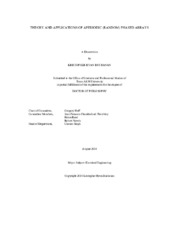| dc.contributor.advisor | Huff, Gregory | |
| dc.creator | Buchanan, Kristopher Ryan | |
| dc.date.accessioned | 2016-09-22T19:39:05Z | |
| dc.date.available | 2016-09-22T19:39:05Z | |
| dc.date.created | 2014-08 | |
| dc.date.issued | 2014-05-29 | |
| dc.date.submitted | August 2014 | |
| dc.identifier.uri | https://hdl.handle.net/1969.1/157918 | |
| dc.description.abstract | A need for network centric topologies using mobile wireless communications makes it important
to investigate new distributed beamforming techniques. Platforms such as micro air vehicles (MAVs),
unattended ground sensors (UGSs), and unpiloted aerial vehicles (UAVs) can all benefit from advances in this area utilizing advantages in stealth, enhanced survivability and maximum maneuverability. Moreover, in this dissertation, electromagnetic radiation is investigated such that the signal power of each element is coherently added in the far-field region of a specified target direction with net destructive interference occurring in all other regions to suppress sidelobe behavior. This provides superior range and resolution characteristics for a variety of applications including; early warning radar, ballistic missile defense and search and rescue efforts.
A wide variety of topologies can be used to confine geometrically these mobile random arrays for analysis. The distribution function for these topologies must be able to generalize the randomness within the geometry. By this means it is feasible to assume the random element distribution of a very large volumetric space will yield either a normal or Gaussian distribution. Therefore the underlying assumption stands that the statistically averaged beam pattern develops from an arrangement of uniformly or Gaussian distrusted elements; both confined to a variety of geometry of radius A and is further generalized using a simple theory based upon the Fourier Transform. Hence, this theory will be derived and serve as the foundation for advanced performance characteristics of these arrays such as its ability for sidelobe tapering, adaptive nulling and multi beam control. In addition it will be shown that for the most ideal of conditions a steerable beam pattern free of sidelobe behavior (better known as a Gaussian distribution) is quite possible. As well these random array structures will be shown to provide superior bandwidth capability over tradiational array structures since they are frequency independent. Last of all a summary of the random array analysis and its results concludes this dissertation. | en |
| dc.format.mimetype | application/pdf | |
| dc.language.iso | en | |
| dc.subject | Random Array | en |
| dc.subject | Collaborative Beamforming | en |
| dc.subject | Opportunistic Array | en |
| dc.subject | Distributed Beamforming | en |
| dc.subject | Aperiodic Array | en |
| dc.subject | Spherical Random Antenna Array | en |
| dc.subject | Circular Random Antenna Array | en |
| dc.subject | Cooperative Systems | en |
| dc.title | Theory and Applications of Aperiodic (Random) Phased Arrays | en |
| dc.type | Thesis | en |
| thesis.degree.department | Electrical and Computer Engineering | en |
| thesis.degree.discipline | Electrical Engineering | en |
| thesis.degree.grantor | Texas A & M University | en |
| thesis.degree.name | Doctor of Philosophy | en |
| thesis.degree.level | Doctoral | en |
| dc.contributor.committeeMember | Chamberland-Tremblay, Jean-Francois | |
| dc.contributor.committeeMember | Nevels, Robert | |
| dc.contributor.committeeMember | Reed, Helen | |
| dc.type.material | text | en |
| dc.date.updated | 2016-09-22T19:39:05Z | |
| local.etdauthor.orcid | 0000-0003-3830-7043 | |


